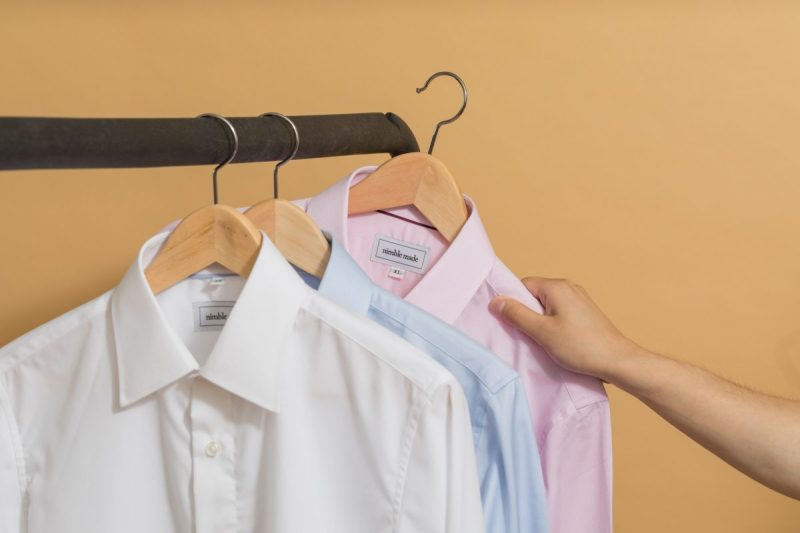
A smart, well-fitted shirt is the basis of many a classic outfit, and a white dress shirt is one of those essential pieces that everyone needs in their wardrobe. But nothing takes a shirt from classy to messy faster than unsightly pit stains. Not to mention the risks of grass, wine, condiments, and all the other things that can stain a good shirt.
Knowing how to deal with stains is an essential skill for keeping your clothes looking their best. But not all stains can be treated the same way, and you need to be careful that your attempts to carefully remove a stain don’t end up making it worse. To get the key info on stain removal, we chatted with with chemical engineer Dr. Daniel H. Jones to get tips on how to remove sweat stains to keep your shirts looking as good as new.

How to handle stains
Jones offers the seemingly simple advice, “Like dissolves like. For instance, use vinegar for coffee and other acidic stains.” Since we are not all chemical engineers, we’ve broken that down further.
- In general, a fresh stain is always easier to treat than an older one, so get on it as soon as possible.
- Gently blot the soiled area with a clean, white paper towel or cloth, but be careful: don’t drive the stain further into the fabric.
- After applying any of the below fixes, do not put items in the dryer unless the stain is completely removed. The dryer will cause the stain to set, making it extraordinarily difficult to remove. We also recommend washing on cold for the same reason: Hot water sets certain stains.

How to get sweat stains out of shirts
Nothing makes a shirt look nasty like a sweat stain does. Most commonly, stains are found in the shirt’s underarms. Why? The culprit is usually aluminum-based chemicals used in antiperspirants that get trapped in the shirt’s fabric when you sweat.
Tackling the stain
Use a mixture of one part dish soap and two parts hydrogen peroxide to attack the stain. According to Jones, the soap has both an “oily” (organic) side and a “salty” (ionic) side. “The ionic side dissolves in water, the organic side dissolves the grease. Hydrogen peroxide breaks down the organic complexes so the soap can dissolve them.”
- Apply the soap/hydrogen peroxide mixture to the stain.
- For particularly stubborn stains, sprinkle baking soda on the soaked area. The grains will provide a bit of abrasion to help dislodge the stain.
- Use a toothbrush (not the one you are currently using for dental hygiene) or a laundry brush to scrub the mixture into the stain.
- Let the cleaning materials soak in for an hour.
- Wash your shirt as normal.

How to remove sweat stains from dark clothing
Hydrogen peroxide may lightly bleach certain colored fabrics, so you should try this method on your stained darker-hued shirts to avoid making the problem worse.
- Run the stain under warm water for a few minutes to thoroughly wet the area.
- Combine 4 tablespoons of baking soda with 1/4 cup warm water to make a paste.
- Apply a generous amount of the paste to the stained area.
- Gently rub your shirt together to help work the paste into the fabric.
- Let the paste sit for 30 minutes and then rinse the area to remove the paste from the shirt.
- Wash as normal.

How to remove collar stains
Are you having a problem with ring around the collar? Yeah, we get that. Those pesky and unsightly stains on the collars of your shirts are caused by a combination of sweat, dead skin cells, oil, and residue from hair products. For this method of stain removal, we’ll rely on the soap’s organic properties to work it all out and get rid of that ugly ring around the collar.
- Lay your shirt flat with the soiled collar facing up.
- Pour undiluted liquid laundry detergent directly onto the soiled area.
- Let the detergent soak into the collar for at least 30 minutes.
- Wash as normal.

How to remove set-in stains
Earlier on, we told you not to put stained clothing in the dryer, because the heat will make the stain set and make it hard to get out. But what if you don’t notice a stain until after the shirt comes out of the dryer? Is it going to be permanently stained, forcing you to replace it?
Thankfully, the answer is no. In this case, bleach is your friend. But not that nasty, old-school chlorine bleach that discolors everything it touches. What you need is oxygen bleach. Oxygen bleach is a color-safe bleach made from sodium carbonate and hydrogen peroxide. It removes stains by releasing oxygen when exposed to water, which works to lift the stains out of the fabric and restore the clothing to its original color. While oxygen bleach is safe for most washable fabrics, always check your label to make sure your clothing can be washed with oxygen bleach.
To use oxygen bleach, pretreat the stained fabric with a stain remover and add the oxygen bleach directly to the water (it works best in warm to hot water) in the washer before adding the clothes, then wash as normal.

How to prevent stains
While there’s only so much you could do for explosive hot dogs, “expressive” glasses of wine, and fruit-fingered toddlers, you could at least try to cut back on those sweat-related problems.
- Limit your caffeine and hot beverage intake. Both increase sweating, which in turn increases the risk of stains.
- Wear a plain white T-shirt under your dress shirt. Your inexpensive tee will bear the brunt of the stain, keeping your pricey dress shirt clean.
- Switch to an antiperspirant with no aluminum compounds or opt for more organic products that will keep you fresh and stain-free while allowing your body to perspire naturally.
- Wear a collar protector. These self-adhesive pads will adhere to your collar, protecting your shirt, while keeping you dry and comfortable.

More sweaty tips to remember
Why do you even get those stains, anyway? Your sweat comes out clear, so why the yellowing of your clothing? It has more to do with your deodorant mixing with the bacteria than anything else. Not only is the tip of switching to an organic deodorant important but so is applying it correctly. But we have other helpful ways to keep the stains away.
- Switch to antiperspirant. This is the stuff that reduces sweating in the first place. You should also be applying this at night before you go to bed. Seriously, read the directions next time.
- If you wear both, put the antiperspirant on before the deodorant.
- Keep your armpit hair short. Just trim it up a bit every now and then.
Keep these items in your car or office
- An extra undershirt
- A bottle of the vinegar mixture
- Organic antiperspirant
If none of these ways to remove sweat stains from shirts or other items doesn’t work, then maybe they get turned into workout clothes. While you should try to prevent those stains from creeping in to start with, at least now you are armed with the ways to bring your shirts back to life after they’ve gone to the pits.
Editors' Recommendations
- A day at the races: How to dress for the Kentucky Derby
- The best chains for men: How to dress up any outfit
- How to style the henley shirt, the versatile men’s fashion item your wardrobe needs
- How pants should fit: A must-read guide for men
- How to wear 1970s fashion if you aren’t Harry Styles




